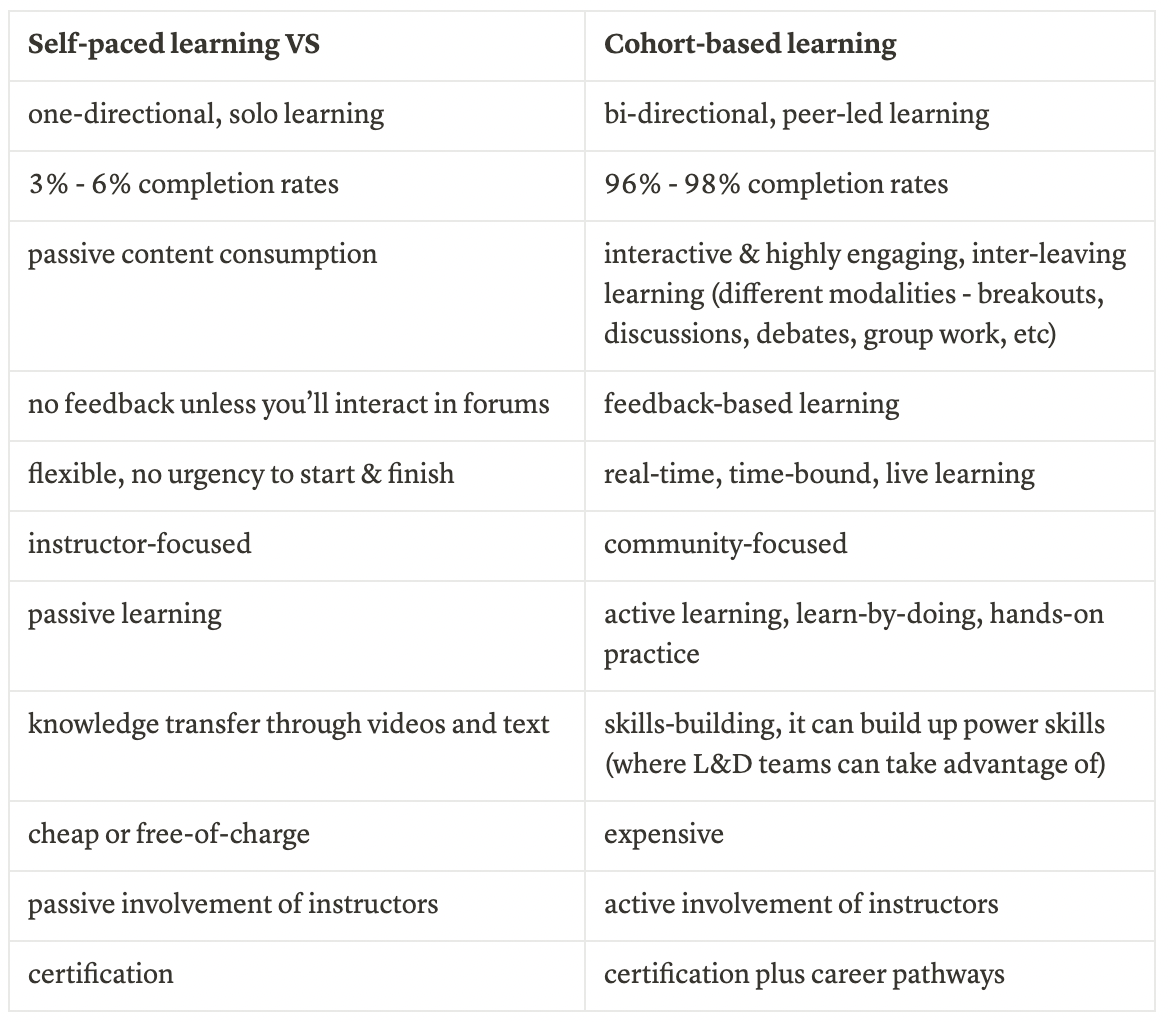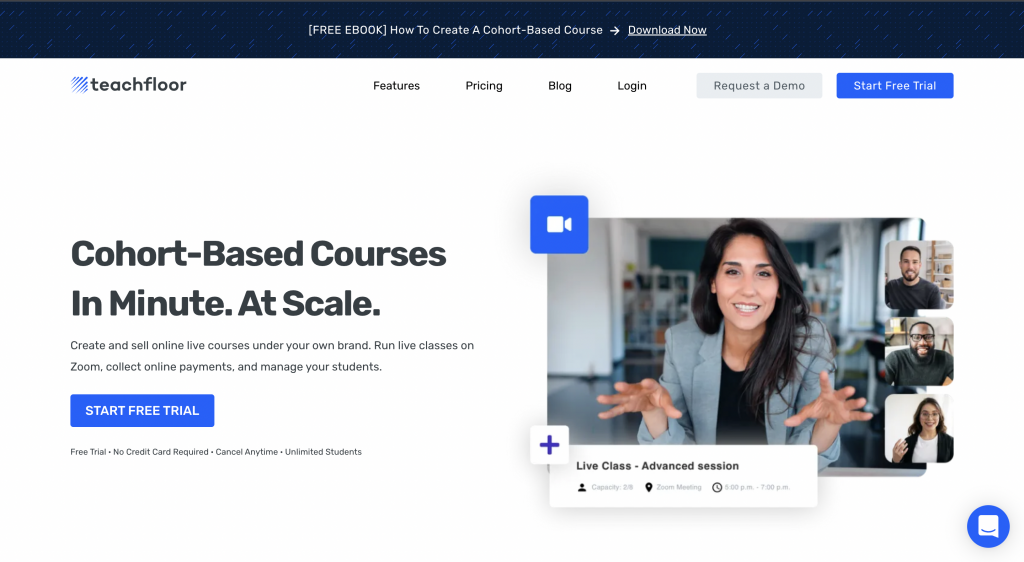How To Scale Cohort-Based Learning
Are you curious to know what’s the future of education and learning? If yes, read on. Learn why it is predicted as the future of education, what are its current challenges, and the 9+ proven strategies to run a scalable cohort-based course without compromising its collaborative learning and community-led approach.
After becoming a trend in 2010, a recent study shows that MOOCs, or self-paced learning, have their disadvantages on learner engagement and completion rates. The main challenge with self-paced learning is the lack of engagement and motivation to finish a course.
Let’s face it. Unless your learning style is learning by yourself, learning at your own pace isn’t easy. Because we, humans, are social beings. We learn best with social interactions.
Cohort-Based Learning As The Future Of Education
Due to this challenge, we innovated learning into a new model called “cohort-based learning” or “learning with others.” This model became popular while the world was under lockdown and while we shifted to learning online. The term was predicted as the future of education by experts. However, how can we prove it’s true?
There are reports, case studies, and businesses that proved the effectiveness of cohort-based learning. Just look at the success of a cohort-based course for writing, Ship30for30. They started from a community of aspiring digital writers and then exploded into cohort learning. Now they are in their 9th cohort, with 4000 alumni. Another one is Ali Abdaal’s Part-Time Youtuber Academy, which made $1.5M in 9 months compared to his earnings of $140K from his self-paced courses.
So, who would have said cohort-based learning isn’t working? Like any other model, there are still pros and cons with this model, that even successful cohorts have seen.
If you’re a course creator, learning designer, or edupreneur who has tried this cohort-based learning with your students, you know what I’m talking about. So, let’s explore these challenges together and discover what are the steps to solve them. First, let’s have an in-depth overview of what cohort-based learning is all about.
What Is Cohort-Based Learning?
According to Teachfloor, “cohort-based learning is a learning environment where students learn and collaborate. It’s highly engaging and learner-centric. It allows students to learn through peers actively.”
It works very well because it’s time-bound and students are forced to learn a specific topic in a specific time frame with their peers. Unlike self-paced, it’s bi-directional, community-led, real-time, and perfect for skills-building.

Who Uses Cohort-Based Learning?
Did you know that cohort-based learning was already used in classrooms even before the pandemic? Yes, even though the term became popular because of online learning, educational institutions have proven its effects on students’ success.
Now that it’s trending, who are the groups that use this model?
Bootcamps
Apparently, tech bootcamps designed their courses in cohorts that allow their students to work in teams. It’s a way for them to show their cohorts how tech teams work in the real world.
Training Programs
Recently, L&D teams discovered how important upskilling is for their employees rather than hiring new ones. Therefore, companies are building their internal academies. Because of this, L&D teams adapted the concept of learning together in a cohort, gamifying training programs to increase knowledge retention and make learning fun.
Coaching Programs
Although coaching is famous for 1:1s, there is also another type, which is group coaching, where a coach holds a focus group discussion. Sometimes, coaches use cohort-based learning to facilitate a group that needs a long-term coaching experience.
Accelerators And Incubators
Learning is a huge part of accelerator and incubator programs. Pitching and raising funds is just the North Star, but the whole process lies down in learning. Accelerators and incubators use cohort-based learning to implement their programs alongside the pitch and networking opportunities.
What Makes It Effective?
Most successful cohorts started in a community. Since cohort-based learning is bi-directional and peer-led, the approach takes away the concept of “star instructors,” where all information comes from the instructor. This happens in self-paced because, typically, you’re learning from the materials given by the instructor. However, cohort-based learning is community-led, where open discussions, forums, and debates are encouraged and everyone is learning from each other.
All of us benefit from the power of technology, where learning goes virtual, global, and diverse. Now, it is possible to learn with cohorts in real-time, live sessions. The magic happens with what they call “interleaving learning,” where students learn in different modalities, such as breakouts, discussions, and debates, and group work happens in real time. The learning becomes highly interactive, engaging, and social.
One of the challenges in self-paced learning is the flexibility of starting and finishing the course. The sense of urgency and limitations with time can force students to take the course and complete it. Having a specific timeline is the reason why completion rates are high and students don’t slack off in finishing what they’ve started.
This is hardly possible in a self-paced course because it’s more of a knowledge transfer than skills-building. In cohort-based, instructors can build up skills with hands-on practice and a “learning by doing” approach.
Cohort-based learning prepares students for the real world with a hands-on approach. It’s inevitable not to think about the career path of your students when you apply cohort-based learning in your course or training. That’s why most tech bootcamps and training programs prepare students’ pathways even after the program.
The Problem With Cohort-Based Learning
Despite the success, there are still challenges that can be improved in this model.
Zoom Fatigue And Time Zone Difference
We have enjoyed the diversity of our cohorts due to online learning. However, we also suffered from Zoom fatigue and time zone difference. Most cohorts are real-time and live to capture learning in the best way possible. But challenges arise with interacting with others virtually during live sessions: staring at your computer, speaking in front of the camera, listening, and checking your face from time to time on the screen.
Not only that, but due to time zone differences, some folks need to learn in real time at one or three in the morning.
Expensive Price
Because it’s time-bound and students have direct interaction with the instructor who happens to be an expert or a celebrity in their field, instructors charge more in exchange for their time and effort. It’s good for instructors. However, it isn’t helpful for students who don’t have the budget to pay for an expensive course.
Active Involvement Of Instructors
The biggest difference between cohort-based and self-paced learning is that instructors aren’t so much involved in self-paced. Whereas in cohort-based, instructors are highly involved, as they need to facilitate sessions in real time rather than create pre-recorded videos.
This means the instructor has to do everything all at once. Unfortunately, even though cohort-based learning is community-led, it still needs someone who leads, moderates the conversation, and supports the members when problems boil up.
The Maximum Number Of Students And Different Skill Levels
MOOCs are designed to scale education. As a course creator, you only need to do the work for a week, launch your course, and viola! Thousands and even millions of students can buy your course with little time and effort from you. Unlike cohort-based, where you can only admit 50–100 students in one cohort.
It isn’t scalable. It’s full of hard work, time, and dedication.
The Solution: Hybrid Cohort-Based Courses
So, how can we scale and solve the underlying challenges in cohort-based learning? Teachfloor, one of the best in its field that helps instructors build and grow their online live academies, has come up with a solution of mixing self-paced and cohort-based learning. We call it a hybrid cohort-based course model.
The concept is similar to semi-synchronous collaborative learning, a term coined by Nomadic Learning. With the right mix of asynchronous and synchronous learning, you can scale your cohort-based course for real.

70% Asynchronous And 30% Synchronous
Mixing up the pros of self-paced, or asynchronous learning, plus the pros of live sessions, or synchronous learning, can scale up your cohort-based course in real time. This mixture also solves time zone differences, the time commitment of instructors, and Zoom fatigue.
All you need to do is to create or reuse your content with pre-recorded videos, texts, and images, with which students can learn at their own pace. Lessen the live sessions from 5 times a week to 1–2 times a week, where you openly discuss, debate, or work with groups on the main topic. Then, for other live group sessions, make them peer-led and facilitated by coaches or mentors.
This is where cohort-based learning happens not with the instructor but with the community itself.
Leverage Technology
Don’t forget that we’re in the 21st century, where you can automate some tasks. Leverage technology through automation and optimization. You can do it by creating your training and courses in all-in-one learning platforms, where everything you need to run your cohort-based course is in one place.
You don’t need to break the bank for this. Some learning platforms like Teachfloor are free for a 14-day trial, and you only need to pay a recurring monthly fee of $59 to admit unlimited students.
Delegate Tasks
No instructor can do this alone. Although, in some cases, this is the reality for other solopreneurs. But if you can onboard mentors, coaches, and community support in building your course, the scaling won’t be too hard for you. Because you can delegate the tasks to your team and you can be focused on the tasks that give you bigger results.
Breaking Down The Cohort Into Subgroups
The best cohort size is around 30–100. More than a hundred is hardly manageable. In hybrid cohort-based, you can at least admit 150–200 students and divide them into subgroups. Then let the coaches or mentors lead these small groups for tight-knit, intensive learning.
Conclusion
Like any other model, cohort-based learning has its pros and cons despite its proven success. The good thing is we can still improve on how we use it and make it in a way that gives us an advantage in the long run. Education isn’t easy to scale. But because of technology and our creative minds, education and learning are now possible to scale without compromising their effectiveness.

